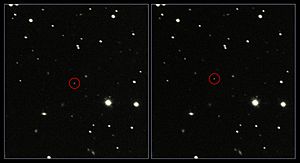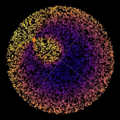Gaia (spacecraft) facts for kids
Gaia is a space observatory. It was launched by the European Space Agency (ESA) on 19 December 2013. The mission aims to compile a 3D space catalogue of about one billion astronomical objects.
It will study about 1% of the Milky way population. A successor to the Hipparcos mission, it is part of ESA's Horizon 2000 Plus long-term scientific program. Gaia will monitor each of its target stars about 70 times over a period of five years.
Gaia will create an extremely precise three-dimensional map of stars throughout the Milky Way galaxy and map their motions. This data is a product of the origin and subsequent evolution of the Milky Way. The spectroscopic measurements will find the physical properties of each star observed, their luminosity, temperature, gravity and elemental composition. The massive stellar census will provide the basic observational data. With the data, astronomers hope to tackle a range of important problems, like the origin, structure, and evolutionary history of our galaxy. Large numbers of quasars, galaxies, extrasolar planets and Solar System bodies will be measured at the same time.
Gaia is being launched using a Soyuz rocket from its Guiana Space Centre (GSC) in French Guiana. It will be operated in a Lissajous orbit around the Sun–Earth L2 Lagrangian point.
Images for kids
-
Gaia's HR Diagram
-
Four maps of the galaxy: radial velocity (top left), proper motion (bottom left); interstellar dust (top right); and metallicity (bottom right).
-
12 Einstein crosses discovered by Gaia in 2021
See also
 In Spanish: Gaia (sonda espacial) para niños
In Spanish: Gaia (sonda espacial) para niños









